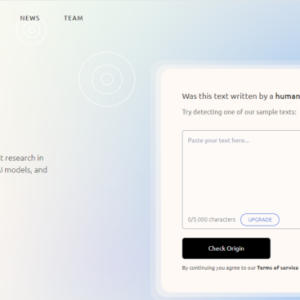As artificial intelligence continues to advance, optimizing for AI systems like ChatGPT has become crucial for businesses and developers alike. ChatGPT is a state-of-the-art language model that can generate coherent and contextually relevant responses to user inputs. However, to achieve the best results and ensure a smooth user experience, it is essential to understand how to optimize your interactions with ChatGPT. In this article, we will explore seven valuable tips that can help you make the most out of ChatGPT and enhance its performance for various applications. From providing explicit instructions to fine-tuning and utilizing system messages, these tips will guide you towards optimizing your AI interactions with ChatGPT.
- AISEO Review: Is This One Of The Best AI Writers On The Market?
- ChatGPT for Real Estate: 8 Great Tactics to Increase Engagement & Sales
- The Benefits and Dangers of Having AI Chatbots Interacting With Your Customers
- The Rise of Therapy Bots: How AI Is Transforming Mental Health Support
- ChatGPT for Online Business: 9 Easy Tips To Sell More & Build Your Brand
Artificial intelligence technology is gaining ground in just about every industry. It can repair code on your website, write an entire novel, and even pass the bar exam. At this point, it’s clear that AI tools aren’t going to go away any time soon, which means you need to know how to optimize for AI like ChatGPT.
You are viewing: How to Optimize for AI Like ChatGPT: 7 Tips To Get the Best Results
How can you get the best results and up-to-date information from ChatGPT and the others in this growing field?
Here is what you need to know to get the best results from any AI tool.
Let’s dive right in.
Keep Inputs Short and Sweet

It can be tempting to feel like you need to explain things in great detail to your AI tools. When you ask a question or submit a request, you actually want to use as few words as possible. It isn’t the same as having a human conversation.
You want to get straight to the point as quickly as possible.
When you optimize for AI like ChatGPT, you should know that it does have the capability of understanding large chunks of text.
However, that can be confusing and might lead you to get less-than-ideal results. Instead, you should be as succinct as you know how. You might be surprised at just how little text you need to get information from machine learning.
Don’t worry too much about being polite with artificial intelligence. Just get right to the point. For example, you might ask it a question like: “Explain a bull market.” You don’t need to ask for permission with a “Can you tell me” or “I was wondering.” Get right to the heart of what you need to know.
Ask for a Specific Task Clearly

On a related note, you also need to make sure that the same technology is given a clear input. If you do ask a question of Google Bard AI or ChatGPT, you need to know exactly what you want to get out of the interaction. Don’t be too vague or ask an overarching question.
Instead, you should make your AI prompts as specific as possible to net accurate responses. Processing language is one of the strengths of an AI tool like ChatGPT, but it can easily get in a pickle if you have too many words.
Before you start working with an AI system, you should know exactly what you hope to gain from your interaction. It uses natural language, so you want to ask targeted questions that have clear answers rather than general opinions.
What is an example of asking ChatGPT alternatives to scour the search engines for your answer? Take a look at how specific some of these questions are:
- Recommend a restaurant that serves brunch on Sundays in Charleston, South Carolina.
- What were the top 10 stocks that performed well in 2020?
- Name the top 5 laptops by sales volume for 2021.
- Find 10 platforms where freelance writers can find clients.
These questions all have very specific functions and answers that AI-powered tools can understand.
Eliminating Technical Terms that Confuse Machine Learning

While you do want to be specific with your AI prompts, you also want to make sure that you aren’t confusing the system with too many terms. ChatGPT and its alternatives come up with human-like responses, but that doesn’t mean they don’t sometimes get confused.
See more : HyperWrite AI Review: Will This AI Tool Improve Your Writing?
AI tools may not understand anything that is overly technical or filled with complex jargon specific to your industry. Try to simplify all of your requests to the very bare minimum text.
For example, you might want to ask a question like: “What jewelry stores in Charleston sell ethically-sourced diamonds with a VS1 clarity or higher and G color scale?”
Unfortunately, this same prompt may cause AI tools to get lost in the weeds and produce a subpar answer. Instead, it should be rephrased to something a little more generic to generate ideas and then move to more specifically designed questions.
A better question to ask would be: “What jewelry stores in Charleston sell ethically-sourced, high-quality diamonds?”
Write Code for Simple Website Updates to Optimize

One of the major benefits of AI-generated content is that it can tackle coding tasks that previously might have taken you hours to piece together. Whether you want it to create a done-for-you snippet of code or to provide you with step-by-step instructions to write it yourself, you get real-time data from the AI-powered chatbot.
This is one area where ChatGPT shines.
You can ask it to come up with code for a specific aspect of building your website, like formatting a blog post or inserting a banner image onto the home page.
Not only does it provide you with written code, but you can even ask it to tell you how and why it did things that way.
Keep in mind that you can write code in multiple languages, including:
- Python
- Javascript
- C#
- PHP
All you have to do is specify what programming language you want in the chat interface, and it can help you come up with code with no time-consuming research or trial and error.
That being said, you should make sure to test your new AI-powered code on your website before you roll it out to your audience. Occasionally, you may find a bug that needs to be corrected before it is fully functional.
The good news is that you can also use ChatGPT to debug your code if something is wrong. It will tell you why something isn’t working and how to go about fixing it.
Find out if ChatGPT can replace programmers and developers here.
Set Character Limits When Needed

One of the most frustrating aspects of marketing is trying to come up with a pithy title that encourages people to click through to your website. Especially if you’re using Google Ads or even Facebook ads, you will be faced with character limits that make it necessary to refine your text to its absolute minimum.
Fortunately, the natural language model of the AI-powered tools makes it easier to get your ads just right. This is a core strategy that you’ll use to optimize for AI like ChatGPT.
When it comes to search engine optimization, you will need to keep your headlines under the minimum. For Google Ads, that means just 30 characters. You might even use it to write the titles for your blog posts or to craft detailed meta descriptions that will actually show up on Google.
See more : Jasper AI Review (Jarvis AI): Is It Still The Best AI Writing Assistant?
To summarize and get excellent titles or descriptions, input the entirety of your text. Even if your current title is 60 characters or more, this lets the AI tool see what you are working with and can help you come up with related keywords. Tell it how many characters you need to trim it down to and let it go to work.
Better yet, you can ask it to give you five to ten options that you can choose from. AI prompts are extremely flexible, but you have to be specific about what you want from them. This user-friendly option can help you save time and is worth noting when it comes to creating content.
Use A/B Testing to Find What Works Best

Are you unsure which description will score more sales for your brand and convert better? The best ChatGPT alternatives are based on large language models, coming up with several options for potential sales pitches (and don’t miss our thoughts on the future of white-collar work in the age of AI here).
Choose your two favorites from your own set of custom answers and run an A/B split test to see which ones perform best. This is a great way to optimize for AI like ChatGPT by harnessing all of its powerful writing abilities.
This could mean that you set up two distinct landing pages and mark which one has the copy that outperforms the other. It could mean sending emails to your list with two different headers and seeing which one converts the best.
No matter what type of content you want to put out there (or update existing content), ChatGPT can assist you with real-time data to help you analyze which one is doing better. All you have to do is feed it the data that you see on the backend, and it can put together a comprehensive report of which one you should stick with and why.
While it may not be up to date on current events (Chat GPT isn’t connected to the internet right now), the language model is still extremely helpful when it comes to language processing and diving deep into the meat of your data.
Give Examples of What You Want

If you asked ChatGPT to deliver something specific using your AI prompts, you might get better results by being as specific as possible. To this end, it can be extremely beneficial to provide clear examples of what you want and how you want it to be formatted.
For example, let’s suppose that you want to use ChatGPT alternatives for keyword research. You could ask it to comb the search engines for popular keywords related to your topic of interest.
However, this might give you a scattershot approach that leaves you feeling frustrated and tired of parsing through the data. Instead, ask it to organize the results in a chart based on search volume and relatedness to the original keyword.
If you intend to use ChatGPT’s natural language model to write a story, you can be specific here too. It isn’t always about real-time data. To give you an example, you could ask it to write a story based on a prompt you provide in the voice of your favorite author.
ChatGPT and ChatGPT alternatives have access to tons of data and information out there on the internet — even if they aren’t connected to search engines right now. Use your prompts to optimize for AI like ChatGPT.
Final Thoughts: How to Optimize for AI like ChatGPT?
If you’re thinking about how AI prompts can benefit you the most, you need to know how to optimize your requests to work with the software. Whether you choose to use ChatGPT or Bard AI, or another large language model altogether, you will find that you can save time by being clear with the platform upfront.
Providing ChatGPT with the tools to be successful is key if you want to make the most of your endeavor.
With some of these specific strategies in mind, you’ll have the ability to parse through what ChatGPT requires in order to get a high-quality output. Start practicing with this tech today to learn more about how you can get the tools you need.
For more information on ChatGPT and maximizing it to its fullest ability, here is some related reading:
- Prompt Engineering: How to Speak to AI to Get What You Want
- ChatGPT for Online Business: 9 Easy Tips to Sell More & Build Your Brand
- ChatGPT for Beginners: Your Quick & Easy Guide to Mastery
That concludes the article: How to Optimize for AI Like ChatGPT: 7 Tips To Get the Best Results
I hope this article has provided you with valuable knowledge. If you find it useful, feel free to leave a comment and recommend our website!
Click here to read other interesting articles: AI
Source: duanetoops.com
#Optimize #ChatGPT #Tips #Results
Source: https://duanetoops.com
Category: AI





